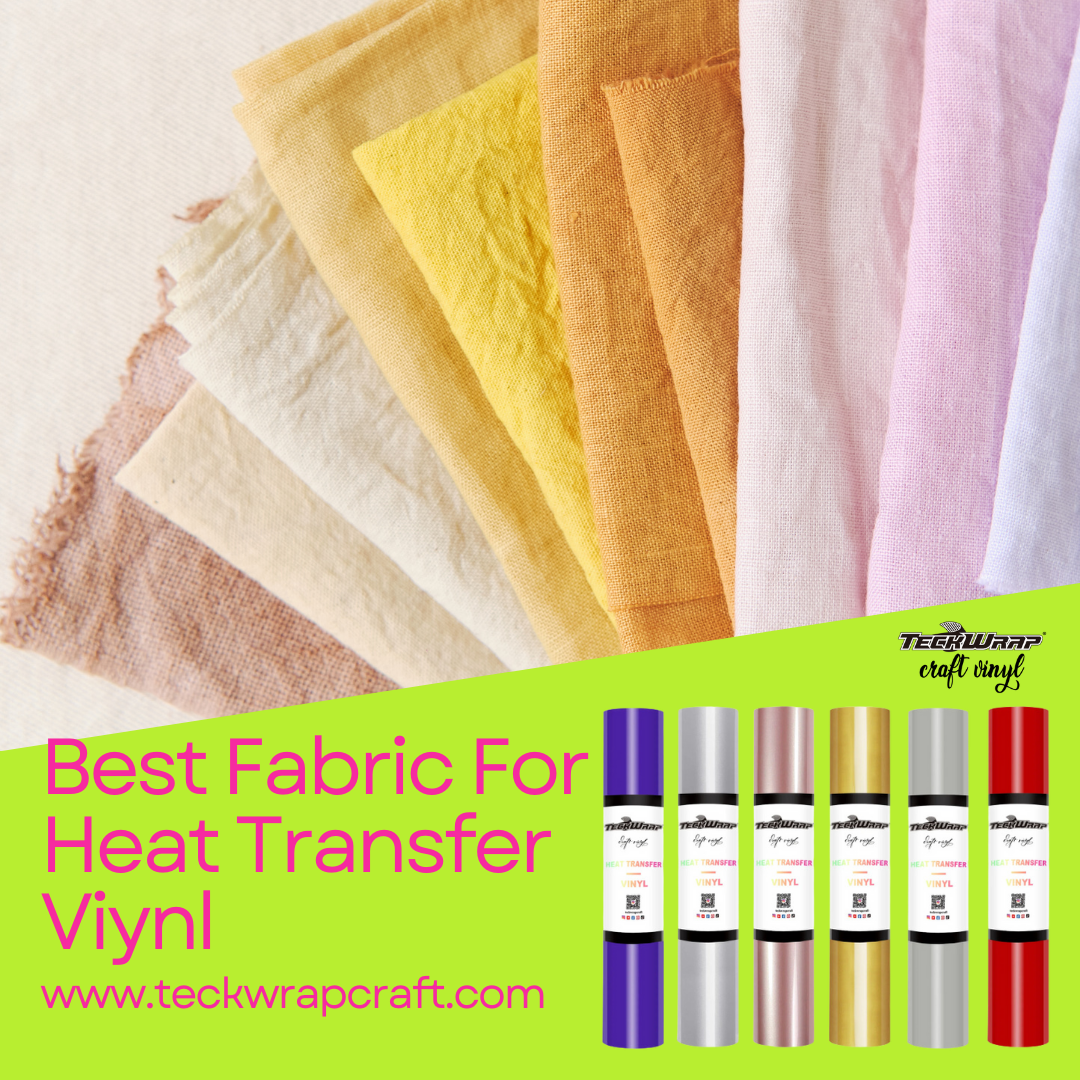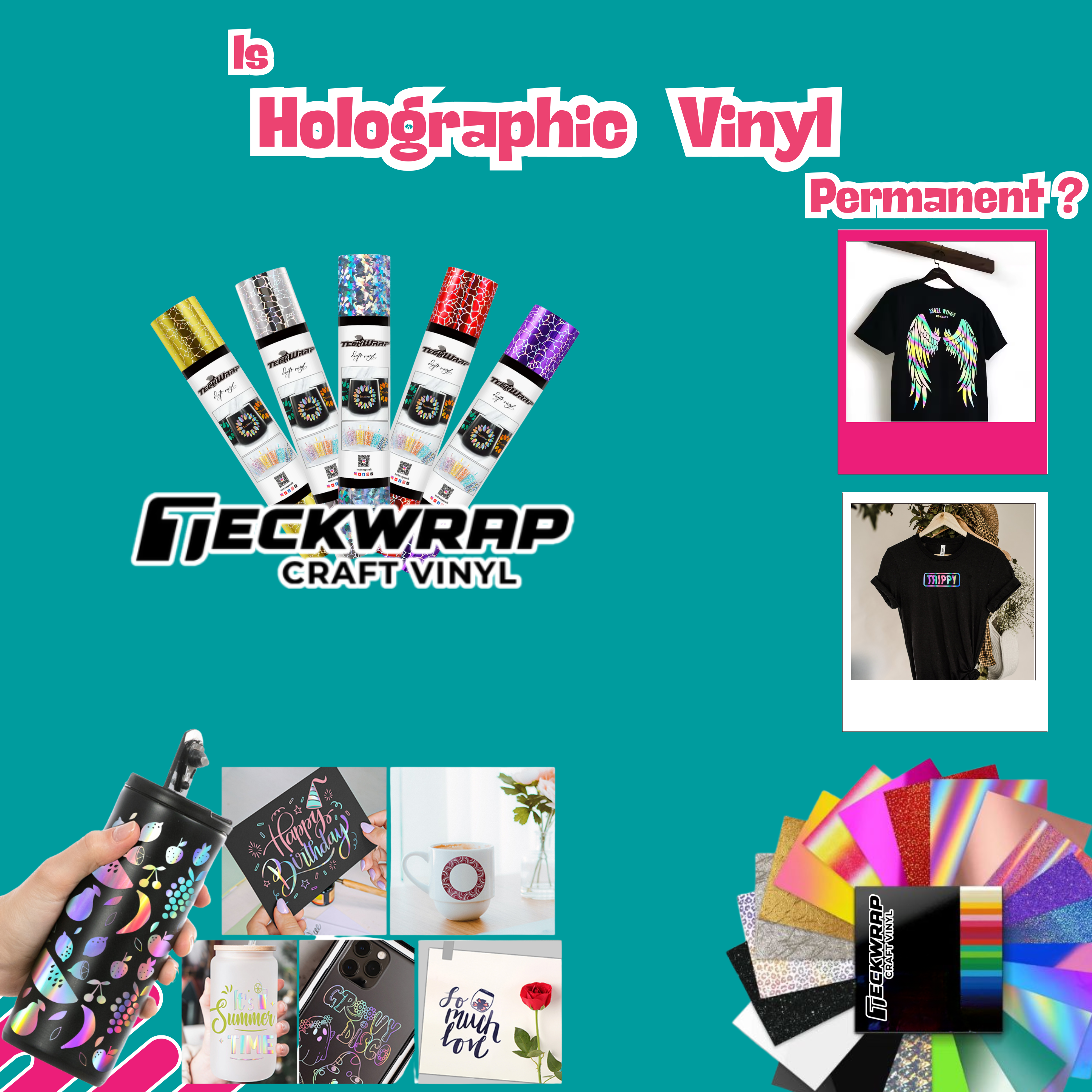Posted By TeckWrap Craft On August 5, 2023
How Long Does Heat Transfer Vinyl Last?

Table Of Contents
- How To Make The Heat Transfer Vinyl Last Longer?
- Do Not Compromise On Quality
- Right Fabric Means Strong Adhesion
- Smooth Surface Matters
- Right Settings Lead To HTV Longevity
- Preparation Is Important
- Use Heat Resistant Material During Transfer
- Even Pressure Longer Life
- Peel It Right
- Let It Cure
- Washing Instructions To Make The HTV Design Last
- Dry The Garment Properly
- Correct Usage And Storage
- What Is The Life Of Heat Transfer Vinyl?
- Properly Storing Heat Transfer Vinyl To Make it Last
- How To Choose Long-Lasting HTV?
- What Reduces The Lifespan Of HTV?
- Frequently Asked Questions
Heat Transfer Vinyl (HTV) is a standout product, cherished by crafters and small-business owners globally. What makes it incredibly promising is the material’s ability to instantly uplift plain fabrics and transform them into exquisite pieces of workmanship. The attention to detail you get with this vinyl is also second to none, as you can create intricate decals and so much more.
But the real question is, How Long Does An HTV Design Last? The finest Heat Transfer Vinyl Lasts For Up To 50 Wash Cycles which may increase if it is properly taken care of. If you want to keep HTV rolls to use later on, their shelf life is Six Months To One Year provided they are stored in appropriate conditions.
Over a period of time, many new brands of heat transfer vinyl have popped up, each vying with the other in a bid to earn more customers. What separates the noise from TeckWrap Craft’s products is their supreme quality. Long-lasting and durable HTV is a guarantee from us. In this blog, we will be analyzing all things related to the lifespan of HTV and how you can make it last longer!
How To Make The Heat Transfer Vinyl Last Longer?
After you have applied an exquisite HTV design to your shirt or any other fabric, it is imperative to take care of it to enhance its life. Regular and proper maintenance can ensure your heat transfer vinyl design lasts longer on your garments. Here are a few tips and tricks you can follow to do just that:

Do Not Compromise On Quality
Invest in high-quality heat transfer vinyl from reputable manufacturers. Quality vinyl is more likely to have better adhesion and resilience, leading to increased durability. The little money you save by compromising on quality results in a totally wasted effort.
Right Fabric Means Strong Adhesion
It is important to use the right fabric for applying heat transfer vinyl so that it lasts long. It is compatible with cotton, polyester, and poly/cotton blends. Avoid fabrics with a lot of texture or stretch, as these may cause the HTV to peel or crack over time. Do complete research on the type of fabric it adheres to well and use that to enhance the life of the design.
Smooth Surface Matters
Take care of seams, buttons, zippers, and snaps on the garment that you are embellishing with heat transfer vinyl. These can affect how well your vinyl adheres to the fabric. If these will come in between, the vinyl might get uneven pressure and your project won’t stick well.

Right Settings Lead To HTV Longevity
Follow the manufacturer's recommendations for time, temperature, and pressure during the heat transfer process. Using the correct settings ensures proper adhesion and prevents under or over-pressing, which can impact longevity.
Preparation Is Important
Ensure the fabric is clean, free of any dust, oils, chemicals, or residues, and properly prepped before applying the HTV so that it lasts longer later on. Washing and drying the garment beforehand can remove any sizing agents or residues that might interfere with adhesion.
If you are using 100% cotton, washing will also pre-shrink it and your design will not get distorted when it is washed after the HTV application. Prepress the fabric as well to remove any moisture and wrinkles, ensuring a smooth surface for the vinyl to adhere to.

Use Heat Resistant Material During Transfer
Placing a Teflon sheet, heat transfer cover sheet, or parchment paper over the vinyl during heat application provides a protective barrier, preventing direct contact of the HTV design with the heat press plate. This helps avoid scorching or damage to the vinyl. The proper application method will improve the lifespan of the vinyl later on.
Even Pressure Longer Life
If you're using a household iron to apply heat or Cricut Easypress, make sure it distributes even pressure across the entire design. Difference in pressure might result in uneven adhesion and lead to premature vinyl failure.
If you are using a household dry iron, place the fabric on a hard surface, and not on the ironing board. Do not move the iron to and fro. Put it on the design and apply pressure. If the design is big make sure all parts of it receive equal pressure.
Peel It Right
Once the heat transfer is complete, it’s time to remove the carrier sheet. Follow the recommended peeling method (warm peel or cold peel) for the specific HTV you're using. Improper peeling can cause the vinyl to lift from the fabric.
If it is a warm peel, allow the garment to cool down a bit before peeling off the carrier sheet so that you don’t burn your fingers. If it is cold peel, allow the design to completely cool down before removing the carrier sheet. This cooling period allows the adhesive to set properly, improving the vinyl's durability.
Let It Cure
Do not wash the garment on which the heat transfer vinyl design is applied for at least 24 to 48 hours. Do not even wear it. This allows the adhesive to set and cure. It will form a strong bond with the fabric and the design will not peel or crack later on.
Washing Instructions To Make The HTV Design Last
Turn garments inside out before washing, use a gentle cycle with mild detergents, and opt for cold or warm water rather than hot water. It is better to gently wash the garment with your hands. Do not rub it or place it with other garments when washing.
Avoid using bleach or fabric softeners, as they can damage the HTV. Bleach might break the adhesive or make the HTV design lose its color vibrance. HTV is not suitable for dry cleaning, as the harsh chemicals involved can damage the vinyl. Stick to the regular laundering methods mentioned above.
Dry The Garment Properly
Air drying or using a low-heat setting in the dryer is preferable to high-temperature drying, as excessive heat can degrade the vinyl. We prefer hanging the garment with the HTV design on the clothesline, away from the sun so that it can air dry naturally.
Correct Usage And Storage
Try to avoid wearing garments with HTV in situations where they may come into contact with abrasive surfaces, which can lead to premature wear and tear reducing the life of the design.
Hang or fold garments with HTV carefully to avoid creasing or unnecessary stress on the vinyl. Take care not to fold the design. When you are ironing the garment, do not apply heat directly to the HTV design. Turn the garment inside out, keep a cloth on top of the design, and then iron it. Do not iron for too long as well.
By following these tips, you can increase the lifespan and durability of HTV on your garments, ensuring they look good for ages to come.
What Is The Life Of Heat Transfer Vinyl?
How long the heat transfer vinyl lasts can vary depending on several factors, including the quality of the vinyl, the application process, the care and maintenance of the garment, and the conditions in which the garment is used.
Generally, heat transfer vinyl can last up to 50 wash cycles. This means roughly one to two years depending on the frequency of usage. Some HTV designs even last for 50 to 100 wash cycles. It all comes down to the quality of the film and maintenance of heat transfer vinyl after application.
If you have bought extra heat transfer vinyl film rolls and want to keep them for later use, they will last for six months to one year easily in proper storage conditions.
Properly Storing Heat Transfer Vinyl To Make it Last
To ensure that your stored vinyl gives you maximum performance you will have to take care of certain important factors, these are:
- Keep HTV in a Cool, Dry Place: HTV should be stored in a dry environment, away from direct sunlight, UV rays, and excessive heat. High temperatures and humidity can cause the vinyl to warp or deteriorate. Ultraviolet rays can make the vinyl lose its color leading to fading. The humidity of the place should also not be more than 50%. Only store vinyl if you can give it this controlled environment.
- Shape Retention: It is important that the vinyl retains its shape. For example, if you are storing HTV sheets, place them flat. Avoid folding or creasing the HTV, as this can cause permanent marks or damage to the material. Store them flat to maintain their shape and prevent deformation.
If you want to keep vinyl rolls, store them upright. Do not place them on the side as they may get compressed. It is better to get a proper tool such as TeckWrap Craft Vinyl Roll Storage with 24 Compartments. It is meticulously crafted to securely accommodate rolls of various sizes using wide elastic bands. They hold the vinyl snugly without damaging or leaving any marks on it. If you have a large supply of HTV, use the ‘first in, first out’ principle to ensure that older vinyl gets used before newer purchases. This helps to prevent older rolls from deteriorating due to long-term storage. - Use Resealable Plastic Bags: Place the HTV in resealable plastic bags. This helps protect it from exposure to air, which can lead to oxidation and reduce its adhesive properties. These bags are transparent so you can easily identify and set them according to color or type. This makes it easier to find what you need without having to rummage through all your supplies.
By following these storage tips, you can help prolong the shelf life and quality of your heat transfer vinyl, ensuring that it remains in excellent condition when you're ready to use it for your crafting projects.
How To Choose Long-Lasting HTV?
Choosing long-lasting heat transfer vinyl is essential to ensure the durability and high performance of your designs on various fabrics and materials. Here are some characteristics and factors you should look out for when selecting HTV:

- HTV is available in different grades and materials. Opt for high-quality vinyl made from trusted brands that provide consistent results such as TeckWrap Craft. We provide premium HTV which is often more durable and resistant to peeling, cracking, and fading. You will also find that our products are easier to apply and cut so you can create wonderful designs.
- The thickness of the HTV plays a significant role in its durability. Thicker HTV tends to be more robust and better suited for items that undergo frequent washing and wearing.
- Look for HTV with strong adhesive properties to ensure that the vinyl adheres firmly to the fabric. A secure bond prevents premature peeling or lifting of the design. TeckWrap Craft uses a strong heat and pressure activated adhesive that can last you years if you follow the provided guidelines on the packaging.
- Ensure that the HTV is suitable for the type of fabric or material you are using. Some vinyl may not adhere well to certain fabrics, so it is crucial to check the product specifications and recommendations. Generally speaking, HTV is most compatible with cotton, polyester, and cotton/poly blend fabrics.
- Consider the flexibility and stretchability of the HTV, especially if you are using it on stretchy or flexible fabrics like athletic wear or spandex. Quality heat transfer vinyl should move with the fabric without cracking or distorting the design.
- Look for HTV that is machine washable and can withstand frequent laundering without deteriorating. Check the recommended washing and care instructions provided by the manufacturer.
- Pay attention to the recommended heat transfer process for the HTV. Some vinyl requires specific temperature and pressure settings for optimal results. Following the correct application process enhances the durability of the design.
- Research customer reviews and recommendations from fellow crafters and hobbyists. Positive feedback and experiences with a particular heat transfer vinyl brand or type can give you confidence in its long-lasting qualities. TeckWrap Craft has built a vast clientele over the years that swears by our products. Head over to our review section and see the recommendations for yourself.
- If environmental impact is a concern for you, look for HTV products that are eco-friendly and comply with safety standards such as the ones available at TeckWrap Craft. We also promote upcycling clothes and sustainable shopping practices with our HTV products.
Remember that proper application and care are essential for maximizing the longevity of any HTV. Always follow the manufacturer's instructions for cutting, weeding, and applying the vinyl to achieve the best results. Taking care of your HTV creations by following washing and care instructions will help ensure they remain vibrant and long-lasting.
What Reduces The Lifespan Of HTV?
The lifespan of HTV can be measured in washes or years. Typically, it lasts up to 50 plus washes or one to two years. However, these numbers can be affected by several factors:
- Heat Exposure: HTV is designed to be applied to fabrics using heat and pressure. However, excessive exposure to heat, such as during prolonged ironing or heat press application, can cause the vinyl to degrade and lose its adhesive properties.
- Friction: HTV can withstand regular wear and tear, but excessive rubbing or friction can cause the vinyl to peel or crack prematurely, reducing its lifespan.
- Washing and Drying: While HTV is generally durable and designed to withstand washing, certain washing conditions can impact its longevity. Harsh detergents, high-temperature wash cycles, and tumble drying at high heat can lead to the HTV deteriorating faster.
- Quality of HTV: The quality of the HTV material itself plays a significant role in determining its lifespan. Higher-quality HTV typically adheres better and lasts longer than lower-quality alternatives.
- Compatibility: The type of fabric or material to which HTV is applied can also influence its lifespan. Some fabrics may not be compatible with HTV, leading to adhesion issues and reduced durability.
- Environmental Factors: Exposure to sunlight and other environmental elements can cause the HTV to fade or degrade over time.
Frequently Asked Questions
Enhance The Life Of Your Heat Transfer Vinyl!
One thing is for certain, having a reliable HTV supplier that does not compromise on quality is key in increasing the lifespan of your projects. TeckWrap Craft’s premium quality vinyl is world-renowned for its durability and the influx of positive feedback from customers globally is a testimony to this fact. If you are on the lookout for craft materials that can help your imagination come to life, order from us today!






